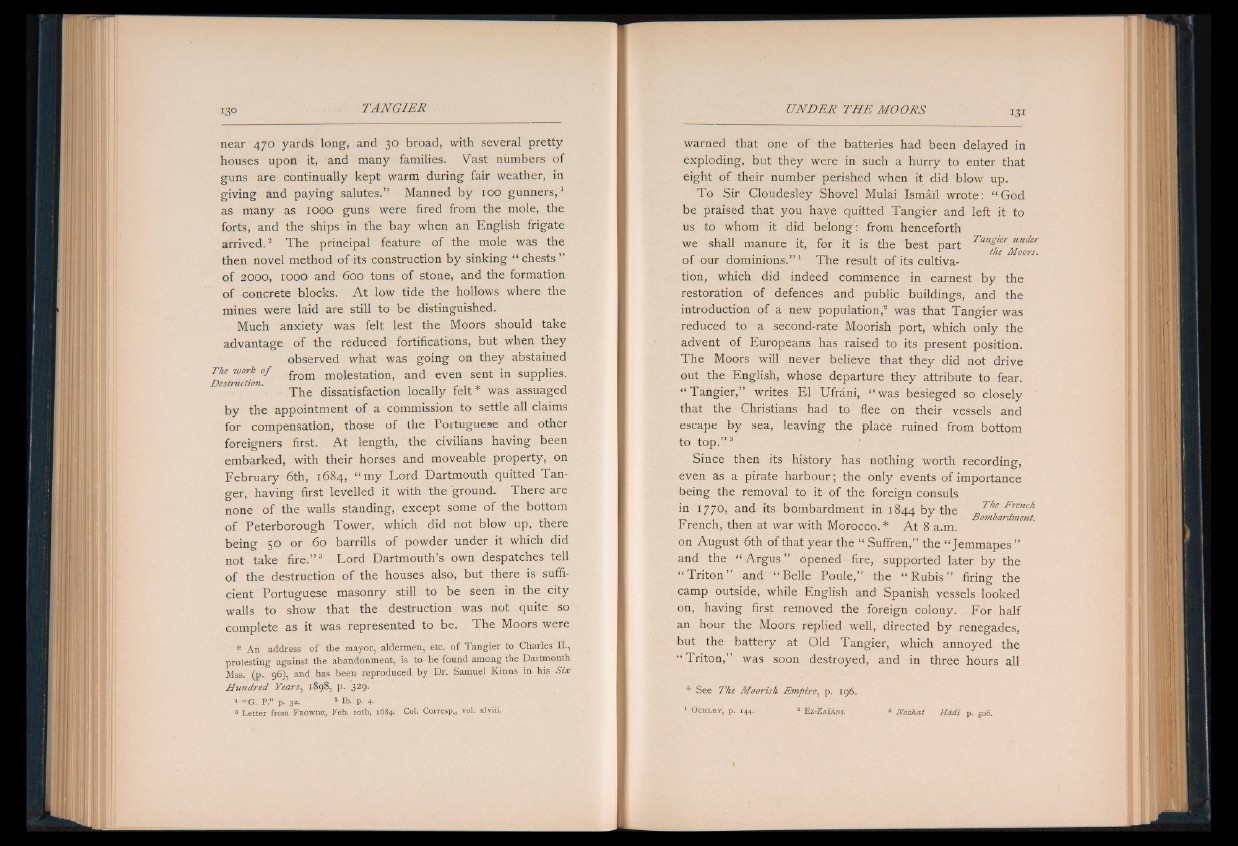
near 470 yards long, and 30 broad, with several pretty
houses upon it, and many families. Vast numbers of
guns are continually kept warm during fair weather, in
giving and paying salutes.” Manned by 100 gunners,1
as many as 1000 guns were fired from the mole, the
forts, and the ships in the bay when an English frigate
arrived.2 The principal feature of the mole was the
then novel method of its construction by sinking “ chests ”
of 2000, 1000 and 600 tons of stone, and the formation
of concrete blocks. A t low tide the hollows where the
mines were laid are still to be distinguished.
Much anxiety was felt lest the Moors should take
advantage of the reduced fortifications, but when they
observed what was going on they abstained
^Destruction^ from molestation, and even sent in supplies.
The dissatisfaction locally felt* was assuaged
by the appointment of a commission to settle all claims
for compensation, those of the Portuguese and other
foreigners first. A t length, the civilians having been
embarked, with their horses and moveable property, on
February 6th, 1684, “ my Lord Dartmouth quitted Tan-
ger, having first levelled it with the ground. There are
none of the walls standing, except some of the bottom
of Peterborough Tower, which did not blow up, there
being 50 or 60 barrills of powder under it which did
not take fire.” 8 Lord Dartmouth’s own despatches tell
of the destruction of the houses also, but there is sufficient
Portuguese masonry still to be seen in the city
walls to show that the destruction was not quite so
complete as it was represented to be. The Moors were
* An address of the mayor, aldermen, etc. of Tangier to Charles II.,
protesting against the abandonment, is to be found among the Dartmouth
Mss. (p. 96), and has been reproduced by Dr. Samuel Kinns in his Six
Hundred Years, 1898, p. 329.
1 “ G‘, P.” p- 32. 2 lb. p. 4.
3 Letter from F r o w d e , Feb. ioth, 1684. Col. Corresp.,. vol. xlviii.
warned that one of the batteries had been delayed in
exploding, but they were in such a hurry to enter that
eight of their number perished when it did blow up.
To Sir Cloudesley Shovel Mulai Ismail wrote: “ God
be praised that you have quitted Tangier and left it to
us to whom it did belong : from henceforth
we shall manure it, for it is the best part Tang^ r “ ”der
• • »-01 Moors. of our dominions. The result of its cultiva-
tion, which did indeed commence in earnest by the
restoration of defences and public buildings, and the
introduction of a new population,2 was that Tangier was
reduced to a second-rate Moorish port, which only the
advent of Europeans has raised to its present position.
The Moors will never believe that they did not drive
out the English, whose departure they attribute to fear.
“ Tangier,” writes El Ufrani, “ was besieged so closely
that the Christians had to flee on their vessels and
escape by sea, leaving the place ruined from bottom
to top.” 3
Since then its history has nothing worth recording,
even as a pirate harbour; the only events of importance
being the removal to it of the foreign consuls
in 1770, and its bombardment in 1844 by the The French
„ . .,,«■■ , Bombardment.
b rench, then at war with Morocco.* A t 8 a.m.
on August 6th of that year the “ Suffren,” the “ Jemmapes ”
and the “ A rg u s ” opened fire, supported later by the
“ Triton” and “ Belle Poule,” the “ Rubis” firing the
camp outside, while English and Spanish vessels looked
on, having first removed the foreign colony. For half
an hour the Moors replied well, directed by renegades,
but the battery at Old Tangier, which annoyed the
“ Triton,” was soon destroyed, and in three hours all
* See The Moorish Empire, p. 196.
1 OCKLEY, p. 144. 2 Ez-ZAÌANI. 3 Nozhat Hädi p. 506.